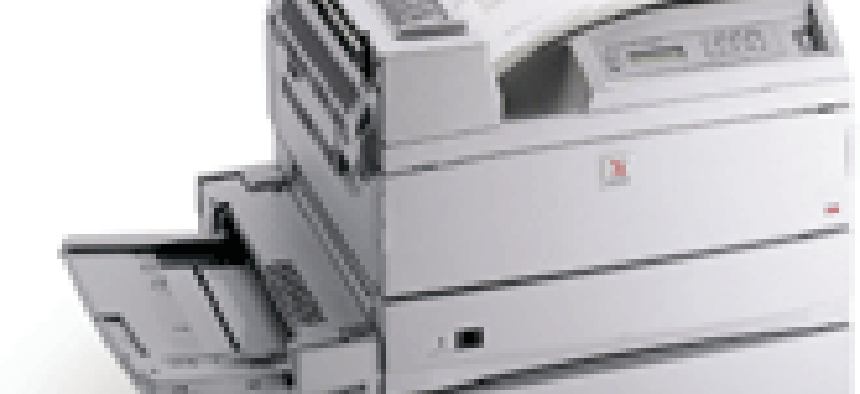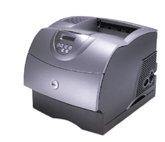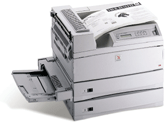Color my world: Printers take on a new hue

Printers have come a long way since the days when lumbering impact printers attached to mainframes, and non-networked PCs pumped out ASCII text symbols on reams of paper that jammed almost as often as not.
Printers have come a long way since the days when lumbering impact printers attached to mainframes, and non-networked PCs pumped out ASCII text symbols on reams of paper that jammed almost as often as not. Reliable, high quality, high-speed printing has become fairly commonplace, but there's always room for improvement and, increasingly, the use of color.Typical speeds of the monochrome units listed in this guide are between 35 and 50 pages per minute. The best color units tend to run slower because of the complexities of bringing crisp color and graphics to the page. Most color lasers top out at 35 pages per minute.Speaking of color, although sales of networkable color lasers are rising fast, they haven't yet caught up with monochrome models. Monochrome text printing still covers the requirements of most offices; when occasional color graphics or photos are called for, an inexpensive color laser or even ink-jet printer will do. But as document management tasks grow more sophisticated, color laser printers grow more desirable.Whether you require color or monochrome printing, the functions and features you should look for are basically the same.All network printers come with a built-in network interface card or some other means of connecting to a network. Network interface support definitely should include 10/100-Mbps Ethernet connectivity, given the universal popularity of this network technology.IEEE 1284 bidirectional parallel port connectivity is another important interface, followed by USB connections. For additional flexibility, check for support of other network protocols such as token-ring, serial port, LocalTalk or AppleTalk. If you are interested in wireless networking, look for IEEE 802.11b WiFi or Bluetooth interfaces.If your printer supports multiple interfaces, it should also support Automatic Interface Switching, so it can switch to the interface selected by the host computer.For network use, lasers require powerful print engines with fast RISC processors to provide fast enough output.The color lasers in the accompanying chart tend to come with faster processors than the monochrome units, because more speed and power is required to handle the extra millions of instructions required for complex image and color graphics management.Network printers are built to last. In addition to robust print engines with plenty of RAM and built-in single-pass technology, other mechanical components are built to withstand years of regular use with infrequent downtime.A standard measure of a printer's ability to handle lengthy service schedules is its monthly duty cycle, as measured in number of pages printed before it must be taken out of service for repair and maintenance. Many of the models listed here boast duty cycles of 250,000 or more pages per month.As a general rule, the more RAM your printer can hold, the better. And though not necessarily a requirement, a hard drive will store more fonts or typefaces, queue up multiple print jobs or store additional drivers.Print resolution of 600 by 600 dots per inch is more than adequate for most tasks. If a printer's specs list a resolution of 1,200 by 1,200 dots per inch, chances are it is enhanced by techniques that help smooth the edges of images on the page and is not a true resolution.Such standard print languages as the various versions of HP PCL or Adobe PostScript should come bundled with your printer. Most of today's printers offer both.What sets the best network printers apart from the pack is the ability to handle large volumes of paper without a blink, hitch or jam.The first and most obvious paper-handling feature is the ability to print two sides of the paper without manual intervention. Automatic two-sided printing should come standard, or at least as an option, with any network printer worth its salt.Second, be sure the printer's paper trays can handle the sizes and stock of paper you use, and that enough input trays can be added to make constant reloading unnecessary.Lexmark International Inc.'s C912fn color laser comes with input trays that can handle up to 5,300 sheets before reloading. Input capacity of at least 2,500 sheets is desirable for most network printers.The printers selected for this guide can handle a variety of paper sizes, ranging from envelope to letter, but only a few of them are equipped to handle tabloid-sized (11-inch by 17-inch) paper stock. If you need this feature, look to a printer such as Hewlett-Packard Co.'s monochrome 9050dn and color 5500hdn or IBM Corp.'s Infoprint 1357n, which can also print banners up to 36 inches long.Expect to pay more for a printer capable of handling tabloid-size or banner print jobs. Oki Data Inc.'s C9500dxn Pro Studio Edition comes standard with a 12-inch by 18-inch extra-tabloid feature and can print 13-inch by 47-inch banner sheets, but it comes at a premium price of $8,788.Only a few network printers come standard with such finishing options as hole punching and stapling and stacking. But most can provide them as options.Virtually all printers listed here provide automatic setup routines that make them a breeze to install on almost any network by almost anybody, including relatively inexperienced administrators.In addition, most have built-in Web pages that let you easily check their status from any computer on the network and provide relevant information about particular print queues.High-quality remote management software has become the crown jewel of most printer manufacturers' bundled software. As network printers by definition are remote ? that is, located some distance from a host computer?some type of remote management is a definite requirement.


J.B. Miles writes from Honomu, Hawaii. E-mail him at jbmiles@starband.net.

The Dell W5300n monochrome printer has a 500-MHz processor, up to 338M of RAM and a 225,000-page monthly duty cycle. It starts at $999.

Xerox's DocuPrint N4525, which starts at $4,899, connects via multiple interfaces, and features automatic duplexing, an internal hard drive and a 250,000-page monthly duty cycle.
J.B. Miles writes from Honomu, Hawaii. E-mail him at jbmiles@starband.net.